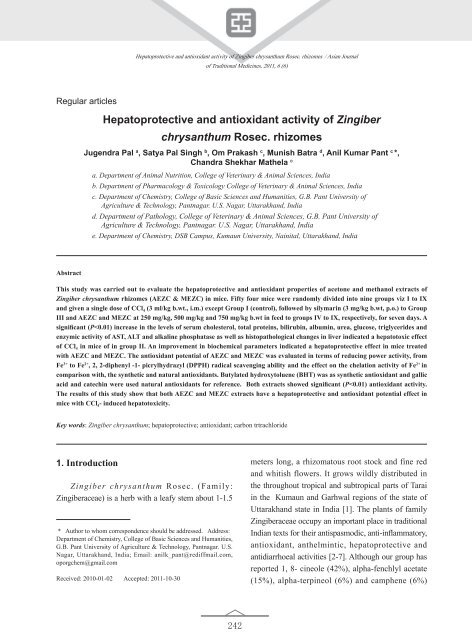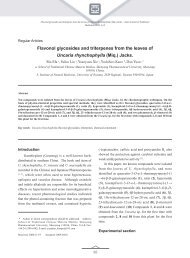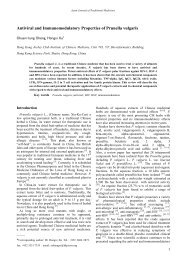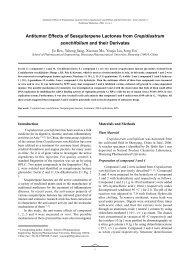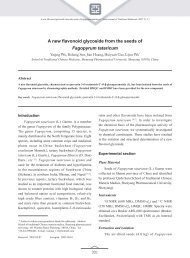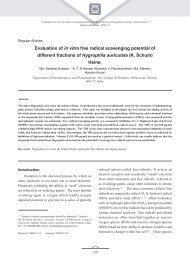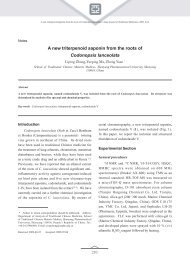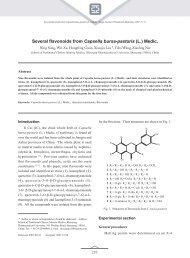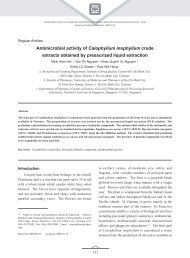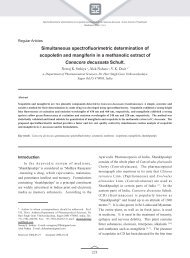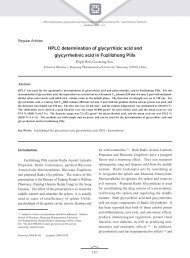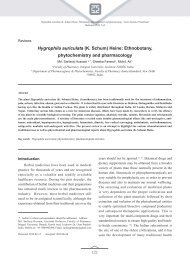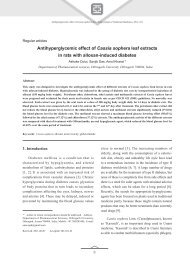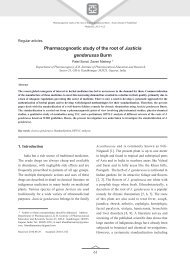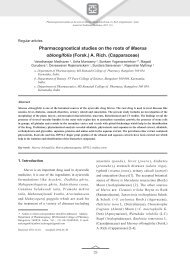Hepatoprotective and antioxidant activity of Zingiber chrysanthum ...
Hepatoprotective and antioxidant activity of Zingiber chrysanthum ...
Hepatoprotective and antioxidant activity of Zingiber chrysanthum ...
- No tags were found...
Create successful ePaper yourself
Turn your PDF publications into a flip-book with our unique Google optimized e-Paper software.
<strong>Hepatoprotective</strong> <strong>and</strong> <strong>antioxidant</strong> <strong>activity</strong> <strong>of</strong> <strong>Zingiber</strong> <strong>chrysanthum</strong> Rosec. rhizomes / Asian Journal<strong>of</strong> Traditional Medicines, 2011, 6 (6)as active principles in the essential oil <strong>of</strong> <strong>Zingiber</strong><strong>chrysanthum</strong> rhizome [8], there are very few scientificreports about its biological <strong>activity</strong>. In view <strong>of</strong> thesefacts, the present study was undertaken to evaluatethe hepatoprotective <strong>and</strong> <strong>antioxidant</strong> <strong>activity</strong> <strong>of</strong> theacetone <strong>and</strong> methanol extracts <strong>of</strong> the rhizome <strong>of</strong> thisplant.2. Materials <strong>and</strong> methods2.1. Collection <strong>of</strong> plant materialThe plant was collected locally from theTarai region <strong>of</strong> Uttarakh<strong>and</strong> <strong>and</strong> was identifiedtaxonomically from the Botanical Survey <strong>of</strong> India(BSI), Dehradun, Uttarakh<strong>and</strong>. The rhizomes wereseparated from the plants for the experiments carriedout in this study.2.2 Solvent extractionFor preparation <strong>of</strong> the acetone <strong>and</strong> methanolextracts <strong>of</strong> <strong>Zingiber</strong> <strong>chrysanthum</strong> (AEZC <strong>and</strong>MEZC) its rhizomes (500 gm) were shade dried<strong>and</strong> powdered. The powder was then subjected tocold extraction with 1000 ml acetone <strong>and</strong>1000 mlmethanol for 5 days. The dried acetone <strong>and</strong> methanolextracts were obtained by evaporation <strong>of</strong> the solventsusing a rotatory vacuum evaporator at 45 ºC±5 ºC<strong>and</strong> kept in a refrigerator until required for furtherinvestigation. The dried extracts were dissolved indistilled water before oral administration to differenttreatment groups.2.3. <strong>Hepatoprotective</strong> <strong>activity</strong>2.3.1. Experimental animalsFemale albino mice 2-2.5 months old weighingbetween 23-28 gm, were obtained from theExperimental Animal House, College <strong>of</strong> Veterinary<strong>and</strong> Animal Sciences, Pantnagar, Uttarakh<strong>and</strong>.The animals were maintained under st<strong>and</strong>ardmanagement condition <strong>and</strong> acclimatized for twoweeks before the start <strong>of</strong> the experiment. Feed <strong>and</strong>water were given ad libitum throughout the study.2.3.2. Experimental designTo evaluate the hepatoprotectivepotential <strong>of</strong>AEZC <strong>and</strong> MEZC in carbon trtrachloride (CCl 4 )-induced hepatic damage, fifty four mice werer<strong>and</strong>omly divided into nine equal groups viz. GroupI to IX. Group I served as a control. Group II to IXreceived a single dose <strong>of</strong> CC1 4 (3 ml/kg. b wt., i m)(99.8% MERCK Specialties Pvt. Ltd.) the on firstday. Group III served as a positive control <strong>and</strong> wasgiven a single daily oral dose <strong>of</strong> silymarin (3 mg/kgb. wt.) for seven days. Groups IV, V <strong>and</strong> VI were fedon a diet containing AEZC at 250 mg/kg, 500 mg/kg,<strong>and</strong> 750 mg/kg b. wt. <strong>and</strong> groups VII, VIII <strong>and</strong> IXwere fed MEZC at 250 mg/kg, 500 mg/kg <strong>and</strong> 750mg/kg b. wt., respectively, for seven days. The micein each group were sacrificed humanely after sevendays <strong>and</strong> blood was collected by cardiac puncture<strong>and</strong> transferred to sterilized non-heaparinizedsyringes to separate serum for biochemicalanalysis <strong>and</strong> liver was collected <strong>and</strong> preserved forhistopathological examinations. The serum wasstored at -10 ºC until biochemical analysis whichwas carried out within 24 hrs.2.4. Biochemical pr<strong>of</strong>ileBiochemical parameters including serumcholesterol, total protein, urea, triglyceride, albumin,glucose, bilirubin <strong>and</strong> serum AST, ALT <strong>and</strong> alkalinephosphatase [9-14] levels were determined usingdiagnostic kits (MERCK Specialties Pvt. Ltd, NewDelhi, India).2.5. Histopathological examinationThe sections <strong>of</strong> liver were processed forhistopathological examination involving tissuefixation <strong>and</strong> were then mounted using DPX formicroscopic examinations [15].243
<strong>Hepatoprotective</strong> <strong>and</strong> <strong>antioxidant</strong> <strong>activity</strong> <strong>of</strong> <strong>Zingiber</strong> <strong>chrysanthum</strong> Rosec. rhizomes / Asian Journal<strong>of</strong> Traditional Medicines, 2011, 6 (6)2.6. Antioxidant <strong>activity</strong>2.6.1. Reducing powerThe reducing power <strong>of</strong> the essential oil <strong>and</strong>AEZC <strong>and</strong> MEZC extracts were determined bythe st<strong>and</strong>ard methods reported earlier [16, 17].Different amounts <strong>of</strong> extracts (5, 10, 15 <strong>and</strong> 20mg) in four test-tubes, were mixed with 2.5 ml <strong>of</strong>the freshly prepared phosphate buffer (200 mM,pH 6.6) <strong>and</strong> 2.5 ml, 1% potassium ferricyanide.The mixture was incubated for 10 min at 50 ºC<strong>and</strong> processed separately. After incubation 2.5 ml10% trichloroacetic acid was added to the mixturefollowed by centrifugation at 650 rpm for 10 min.The upper layer (5 ml) was decanted <strong>and</strong> mixed with5ml distilled water <strong>and</strong> 1.0 ml 0.1% ferric chloride.Each tube was shaken well <strong>and</strong> the absorbance<strong>of</strong> the resultant solution was measured at 700 nmusing a UV- Vis-spectrophotometer (Visiscon-167).The control was subjected to the same procedure<strong>and</strong> BHT, gallic acid <strong>and</strong> catechin were used asst<strong>and</strong>ards.2.6.2. Effect on the chelating <strong>activity</strong> <strong>of</strong> Fe 2+The chelating <strong>activity</strong> <strong>of</strong> the essential oil onferrous ions (Fe 2+ ) was measured as describedwith slight modification [18]. Different amounts<strong>of</strong> extracts (5 mg, 10 mg, 15 mg <strong>and</strong> 20 mg) weremixed in separate test- tubes with 1 ml methanol <strong>and</strong>3.7 ml distilled water. The mixtures were allowed toreact with FeCl 2 (2 mM, 0.1ml) <strong>and</strong> ferrozine (5 mM,0.2 ml) for 10 minutes at room temperature <strong>and</strong> thenthe absorbance <strong>of</strong> each was recorded at 562 nm. Alower absorbance indicates a higher chelating power.The Fe 2+ chelating <strong>activity</strong> <strong>of</strong> the oil <strong>and</strong> extractswas compared with that <strong>of</strong> EDTA at a concentration<strong>of</strong> 0.01 mM <strong>and</strong> citric acid at a concentration <strong>of</strong>0.025 M. The chelating <strong>activity</strong> was calculated fromthe following equation:Chelating <strong>activity</strong> (%) = [1– (A t /A 0 )]×100%where A t is the absorbance <strong>of</strong> the samples at 562nm <strong>and</strong> A 0 is the absorbance <strong>of</strong> the control at 562 nm2.6.3. DPPH radical scavenging <strong>activity</strong>The scavenging effect on DPPH radicals wasdetermined using methods developed earlier [16, 17,19]. Different concentration <strong>of</strong> extracts (5 mg, 10 mg,15 mg <strong>and</strong> 20 mg) were mixed with 5 ml 0.004%methanolic solution <strong>of</strong> DPPH. Each mixture wasincubated for 30 minutes <strong>and</strong> the absorbance <strong>of</strong> thesamples was read at 515 nm. The DPPH solution wasfreshly prepared before use <strong>and</strong> kept in a coveredflask in a dark place at 4 ºC during the measurements.The control <strong>and</strong> st<strong>and</strong>ard with a lower absorbanceindicated a higher radical scavenging <strong>activity</strong> whichwas calculated from the equation:DPPH scavenging <strong>activity</strong> (%) = [1– (A t /A 0 )] ×100%where A t is the absorbance <strong>of</strong> the samples at 515nm <strong>and</strong> A 0 is the absorbance <strong>of</strong> the control at 515 nm2.7. Statistical analysisData were expressed as Mean±S.E. <strong>and</strong> analyzedstatistically for significant differences using one wayANOVA at a 1% level Statistics <strong>of</strong> significance.3. ResultsThe results <strong>of</strong> biochemical parametersrecorded seven days post-treatment to evaluatehepatoprotective efficacy <strong>of</strong> AEZC <strong>and</strong> MEZCin mice with CCl 4 -induced hepatotoxicity arepresented in Table 1. The biochemical parametersindicative <strong>of</strong> hepatotoxicity were significantlyincreased in the CCl 4 -treated group in comparisonwith the untreated control. A significant (P
<strong>Hepatoprotective</strong> <strong>and</strong> <strong>antioxidant</strong> <strong>activity</strong> <strong>of</strong> <strong>Zingiber</strong> <strong>chrysanthum</strong> Rosec. rhizomes / Asian Journal<strong>of</strong> Traditional Medicines, 2011, 6 (6)Table 1. Biochemical parameters recorded seven days post- administration <strong>of</strong> CCl 4 <strong>and</strong> Z <strong>chrysanthum</strong> rhizome extracts toevaluate the hepatoprotective efficacy <strong>of</strong> AEZC <strong>and</strong> MEZCGroupsTreatment(Dose)Cholesterol(mg/dl)(mean±SE)Total Protein(g/dl)(mean±SE)Bilirubin(mg/dl)(mean±SE)Albumin(mg/dl)(mean±SE)UREA(mg/dl)(mean±SE)I Control 99.06±1.63 07.15±0.08 0.55±0.02 2.62±0.12 18.81±0.26II CCl 4 (3ml/kg.b.wt) 146.48±2.34 a 12.21±0.20 a 0.86±0.01 a 4.18±0.18 a 117.05±5.12 aIIIIVVVIVIIVIIIIXGroupsCCl 4 (3ml/kg.b.wt) +silymarin (3mg/kg. b.wt.)CCl 4 (3ml/kg.b.wt) +AEZC (250 mg/kg. b.wt.)CCl 4 (3ml/kg.b.wt) +AEZC (500 mg/kg. b.wt.)CCl 4 (3ml/kg.b.wt) +AEZC (750 mg/kg. b.wt.)CCl 4 (3ml/kg.b.wt) +MEZC (250 mg/kg. b.wt.)CCl 4 (3ml/kg.b.wt) +MEZC (500 mg/kg b.wt.)CCl 4 (3ml/kg.b.wt) +MEZC (750 mg/kg b.wt.)Treatment(Dose)114.07±3.17 b 8.78±0.09 b 0.84±0.04 b 2.89±0.04 31.50±0.33 b127.63±3.17 bc 10.46±0.15 bc 0.88±0.06 b 3.83±0.10 bc 96.15±4.96 bcd123.12±1.65 bc 10.81± 0.13 bcd 1.45±0.07 bcd 3.63±0.14 bc 90.40±1.25 bcd115.52±1.55 b 10.25±0.11 bcd 0.54±0.03 cd 3.03±0.06 bcd 76.87±0.80 bcd124.93±1.57 bc 10.22±0.18 bcd 0.73±0.04 b 3.44±0.11 bc 32.47±0.29 bd116.28±0.64 b 9.40±0.09 bcd 0.69±0.04 d 3.12± 0.10 b 34.88±0.39 bd111.45±0.90 b 9.40±0.094 bcd 0.53±0.027 cd 3.66± 0.070 bcd 38.09±0.47 bdGlucose(mg/dl)(mean±SE)Triglyceride(mg/dl)(mean±SE)ALT (U/l)(mean±SE)AST (U/l)(mean±SE)Alkalinephosphatase (U/l)(mean ± SE)I Control 47.56±1.63 94.30±3.56 13.26±0.26 52.95±0.26 384.18±10.12II CCl 4 (3ml/kg.b.wt) 110.26±2.67 a 149.22±8.05 a 17.55±0.26 a 57.66±0.37 a 418.60±0.71 aIIIIVVVIVIIVIIIIXCCl 4 (3ml/kg.b.wt) +silymarin (3mg/kg. b.wt.)CCl 4 (3ml/kg.b.wt) +AEZC (250 mg/kg. b.wt.)CCl 4 (3ml/kg.b.wt) +AEZC (500 mg/kg. b.wt.)CCl 4 (3ml/kg.b.wt) +AEZC (750 mg/kg. b.wt.)CCl 4 (3ml/kg.b.wt) +MEZC (250 mg/kg. b.wt.)CCl 4 (3ml/kg.b.wt) +MEZC (500 mg/kg b.wt.)CCl 4 (3ml/kg.b.wt) +MEZC (750 mg/kg b.wt.)54.02±2.95 101.03±4.00 14.35±0.10 b 54.72±0.16 b 378.83±18.07110.92±2.35 bcd 124.52±8.97 bc 14.15±0.57 56.41±0.31 bd 158.35±8.78 bcd119.49±1.32 bcd 190.67±7.92 bcd 14.23±0.59 54.97±0.20 b 177.17±9.47 b127.31±2.00 bcd 102.95±3.26 14.34±0.39 55.13±0.19 bc 167.07±9.42 bcd32.97±2.06 bcd 103.45±3.18 d 14.93±0.47 b 55.91±0.41 bd 319.00±8.57 bcd42.50±1.10 bcd 64.93±2.57 bcd 14.23±0.62 55.17±0.26 b 310.28±6.65 bc47.84±1.15 bd 107.08±2.8 15.39±0.32 b 55.03±0.16 b 326.80± 8.15 bcdaP
<strong>Hepatoprotective</strong> <strong>and</strong> <strong>antioxidant</strong> <strong>activity</strong> <strong>of</strong> <strong>Zingiber</strong> <strong>chrysanthum</strong> Rosec. rhizomes / Asian Journal<strong>of</strong> Traditional Medicines, 2011, 6 (6)treated group. There was no significant differencein serum cholesterol level in the higher dose groupV give AEZC <strong>and</strong> VIII <strong>and</strong> group IX given MEZCin comparison with the silymarin-treated group III.The total serum proteins levels were significantly(P
<strong>Hepatoprotective</strong> <strong>and</strong> <strong>antioxidant</strong> <strong>activity</strong> <strong>of</strong> <strong>Zingiber</strong> <strong>chrysanthum</strong> Rosec. rhizomes / Asian Journal<strong>of</strong> Traditional Medicines, 2011, 6 (6)phosphatase were found in CCl 4 -treated miceindicating liver damage, although, these values werereduced significantly (P
<strong>Hepatoprotective</strong> <strong>and</strong> <strong>antioxidant</strong> <strong>activity</strong> <strong>of</strong> <strong>Zingiber</strong> <strong>chrysanthum</strong> Rosec. rhizomes / Asian Journal<strong>of</strong> Traditional Medicines, 2011, 6 (6)4.3. DPPH radical scavenging <strong>activity</strong>DPPH radical scavenging <strong>activity</strong> wasobserved for all the tested extracts at the selecteddose levels (5 mg, 10 mg, 15 mg <strong>and</strong> 20 mg),although these extracts differed in their ability toreact with <strong>and</strong> quench DPPH radicals. However,there were variations in the scavenging <strong>activity</strong> <strong>of</strong>DPPH scavenging <strong>activity</strong> <strong>of</strong> acetone, hexane <strong>and</strong>methanol extracts <strong>of</strong> rhizomes <strong>of</strong> Z. <strong>chrysanthum</strong><strong>and</strong> the methanolic extract exhibited the maximumscavenging <strong>activity</strong> (74.60±0.05) followed by theacetone (65.25±0.08) <strong>and</strong> hexane extracts (60.32±0.58) at a dose level <strong>of</strong> 20 mg (Fig. 4). It is wellFig: 1known that freeFig: Reducing 1 Reducing power power <strong>activity</strong> <strong>activity</strong> <strong>of</strong> acetone,hexane <strong>of</strong> acetone,hexane <strong>and</strong> <strong>and</strong>radicals cause auto oxidationmethanol methanol extracts extracts <strong>of</strong> rhizomes <strong>of</strong> rhizomes <strong>of</strong> Z. <strong>chrysanthum</strong><strong>of</strong> Z. <strong>chrysanthum</strong><strong>of</strong> unsaturated lipids in food [37]. In addition,4.5 4.5<strong>antioxidant</strong>s are known to interrupt the free radical4 4chain3.5reaction <strong>of</strong> oxidation <strong>and</strong> donate hydrogen3.5AEZCfrom 3phenolic hydroxyl groups, thereby formingAEZC3MEZC MEZC2.5stable free 2.5 radicals, which do not initiate HEZC HEZC or2 2BHT BHTpropagate further oxidation <strong>of</strong> [38]. Many medicinal Catechin1.5 1.5Gallic acidplants contain large amount <strong>of</strong> <strong>antioxidant</strong>s other1 1than 0.5vitamins <strong>and</strong> cartenoids [39]. Various type<strong>of</strong> ginger 0 0 in tropical countries have been shown5mg 5mg 10mg 10mg 15mg 15mg 20mg 20mgto have strong anti-oxidative Concentrations Concentrationsactivities that couldreplace α-tocopherol [40]. Recent reports havedescribed that <strong>antioxidant</strong> compounds with radicalscavenging Fig:3 <strong>activity</strong> DPPH Fig:3 DPPH radical are radical scavenging present scavenging <strong>activity</strong> onion, <strong>activity</strong> <strong>of</strong> <strong>of</strong> garlic,AbsorbanceDPPH DPPHscavenging radical scavenging effect effect (%) (%)Absorbance120100DPPHscavenging effect (%)806040200acetone,hexane acetone,hexane <strong>and</strong> methonal <strong>and</strong> methonal extracts extracts <strong>of</strong> rhizomes <strong>of</strong> rhizomes <strong>of</strong> <strong>of</strong>Z.<strong>chrysanthum</strong> Z.<strong>chrysanthum</strong>1201008060402005mg 5mg 10mg 10mg 15mg 15mg 20mg 20mgConcentrations ConcentrationsFig:2 Fig:2 Chelating Chelating <strong>activity</strong> <strong>activity</strong> <strong>of</strong> acetone,hexane <strong>of</strong> acetone,hexane <strong>and</strong> <strong>and</strong>methanol methanol extracts extracts <strong>of</strong> rhizomes <strong>of</strong> rhizomes <strong>of</strong> Z.<strong>chrysanthum</strong><strong>of</strong> Z.<strong>chrysanthum</strong>AEZC AEZCMEZC MEZCHEZC HEZCBHT BHTGallic Gallic acid acidCatechin CatechinFig. 4. DPPH radical scavenging <strong>activity</strong> <strong>of</strong> acetone, hexane<strong>and</strong> methanol c\extracts <strong>of</strong> rhizomes <strong>of</strong> Z. <strong>chrysanthum</strong>CatechinGallic acidsage <strong>and</strong> thyme extracts [41, 42]. Therefore, wedetermined <strong>of</strong> radical scavenging <strong>activity</strong> <strong>of</strong> theessential oil <strong>of</strong> zingiberaceous plants. The 2, 2´-diphenyle-1-picrylhydrazyl radical has been widelyused to evaluate the free radical scavenging capacity<strong>of</strong> <strong>antioxidant</strong>s [43-45]. The determination <strong>of</strong> thescavenging stable DPPH radical is a very fast methodfor evaluating the <strong>antioxidant</strong> <strong>activity</strong>. Using thismethod, it is possible to determine the anti-radicalpower <strong>of</strong> the <strong>antioxidant</strong> <strong>activity</strong> by measurement<strong>of</strong> the reduced absorbance <strong>of</strong> the DPPH radicalat 515 nm. In the radical forms this molecule hasan absorbance at 515 nm which disappears afteracceptance <strong>of</strong> an electron or hydrogen radical from an<strong>antioxidant</strong> compound to become a stable diamagneticmolecule [46]. The data obtained revealed thatall the essential oils <strong>and</strong> extracts are free radicalsscavengers <strong>and</strong> thus, primary <strong>antioxidant</strong>s thatreact with free radicals. The <strong>antioxidant</strong> <strong>activity</strong> <strong>of</strong>natural <strong>antioxidant</strong>s has been shown to be involvedin termination <strong>of</strong> free radical reactions <strong>and</strong> theassociated Fe 3+ to Fe 2+ reducing power [19, 47].From these results it can be concluded that all theextracts exhibited significant differences in their<strong>antioxidant</strong> potential, presumably due to differencesin the structure <strong>and</strong> concentration <strong>of</strong> the <strong>antioxidant</strong>components. Among these the acetone, hexane <strong>and</strong>methanol extract <strong>of</strong> rhizomes <strong>of</strong> Z. <strong>chrysanthum</strong>showed clear variations in their anti-oxidantpotential. These variations in activities may bedue to differences in their chemical composition.The antioxidative activities observed for all theessential oils <strong>and</strong> extracts could be a synergisticeffect <strong>of</strong> more than the four compounds that maybe present in the system. It has been reported thatmost natural anti oxidative compound <strong>of</strong>ten worksynergistically with each other to produce a boardspectrum <strong>of</strong> <strong>antioxidant</strong> <strong>activity</strong> creating an effectivedefense system against free radical attack [48].These essential oils <strong>and</strong> extracts could be used asnatural <strong>antioxidant</strong>s <strong>and</strong> a possible substitution70607060249
<strong>Hepatoprotective</strong> <strong>and</strong> <strong>antioxidant</strong> <strong>activity</strong> <strong>of</strong> <strong>Zingiber</strong> <strong>chrysanthum</strong> Rosec. rhizomes / Asian Journal<strong>of</strong> Traditional Medicines, 2011, 6 (6)553-557.[23] Asha VV, Preliminary studies on the hepatoprotective<strong>activity</strong> <strong>of</strong> Mamordica subangulata <strong>and</strong> Nargamia alata,Indian J Pharm, 2001, 33: 276.[24] Thabrew MI, Joice PD, Rajasissa W. Comparative study<strong>of</strong> the efficacy <strong>of</strong> pavetta indica <strong>and</strong> Osbeckia oct<strong>and</strong>rain treatment <strong>of</strong> liver dysfunction. Planta Med, 1987,53(3): 239-241.[25] Awang D. Milk Thistle. Can Pharm J, 1993, 23: 749.[26] Vishwakarma SL, Goel RK. <strong>Hepatoprotective</strong> <strong>activity</strong><strong>of</strong> Enicostemma littorale in CCl 4 - induced liver damage.Asiaa J Biochem, 1988, 3: 308-314.[27] Chung YC, Chang CT, Chao WW, Lin CF, Chou ST.Antioxidant <strong>activity</strong> <strong>and</strong> safety <strong>of</strong> the 50% ethanolicextract from red bean fermented by Bacillus subtilisIMR-NKI. J Agric Food Chem, 2002, 50: 2454-2458.[28] Yen GC, Chen HY, et al. Antioxidant <strong>activity</strong> <strong>of</strong> varioustea extracts in relation to there mutagen city test. J AgricFood Chem, 1995, 43: 27-32.[29] Shimada K, Fujikawa K,Namakura T. Antioxidativeproperties <strong>of</strong> xanthon on auto oxidation <strong>of</strong> soybean oilin cyclodextrin emulsion, J Agric Food Chem, 1992, 40:945-948.[30] Pin-Der D,Antioxidant <strong>activity</strong> <strong>of</strong> budrock (Arctiumlaooa Linn): Its scavenging effect on free radicals <strong>and</strong>active oxygen. J Am Oil Chem Soc, 1998, 75: 455-461.[31] Miller DD, Mineral in O.R. Fennema (Ed.), Food Chem.New YORK; Marcel Deckker. 1996, 611-649.[32] Halliwell B, Gutteridge JMC. Oxygen Toxicology,oxygen radicals, transition metal <strong>and</strong> disease. Bio J,1984, 219: 1-4.[33] Yamaguchi F, Ariga T, Yoshimira Y, Nakazawa H.Antioxidant <strong>and</strong> anti-glycation <strong>of</strong> carcinol fromGarcinia indica Fruit Rind. J Agric Food Chem, 2000,48(2): 180-185.[34] Mau JL, Eric YCL, Wang NP, Chen CC, Chang CH,Chyau CC. Composition <strong>and</strong> <strong>antioxidant</strong> <strong>activity</strong> <strong>of</strong> theessential oil from Curcuma zedoria. Food Chem, 2003,82: 583-591.[35] Chen X, Ahn DU. Antioxidant <strong>of</strong> six phenolics againstlipid oxidation by Fe 2+ or ultraviolet light. J Amer OilChem Soci. 1998, 75(12): 1717-1721.[36] Mahoney JR, Graf E. Role <strong>of</strong> α-Tocopherol, ascorbicacid <strong>and</strong> EDTA as <strong>antioxidant</strong> im model system. J FoodSci, 1986, 51: 1293-1296.[37] Kaur H, Perkins J. The free radical-chemistry <strong>of</strong> foodadditives. In: Aruoma OI, Halliwell B (Eds.), freeradical food <strong>and</strong> food additives. New York. 1991, 17-35.[38] Sherwin ER, Oxidation <strong>and</strong> <strong>antioxidant</strong>s in fat <strong>and</strong> oilprocessing. J Amer oil Chem Soci, 1978, 55: 809-841.[39] VeliogluYS, Mazza G, Gao L, Oomah BD. Antioxidant<strong>activity</strong> <strong>and</strong> total phenolics in selected fruits, vegetables<strong>and</strong> grain products. J Agric Food Chem, 1998, 46:4113-4117.[40] Jitoe A, Masuda T, Tengah IGP,Suprapta DN, Gara IW,Nakatani N. Antioxiative <strong>activity</strong> <strong>of</strong> tropical gingerextract <strong>and</strong> analysis <strong>of</strong> the contained curcumenoids. JAgri Food Chem, 1992, 40: 1337-1340.[41] Miura K, Kikuzaki H, Nakatai N. Antioxidant <strong>activity</strong><strong>of</strong> chemical components from sage (salvia <strong>of</strong>ficinalisL.) <strong>and</strong> (Thymus vulgaris L.) measured by the oilstability index method. J Agric Food Chem, 2002, 50:1845-1851.[42] Nuutila AM, Pimia RP, Aarni M, Caldentey KMO.Comparision <strong>of</strong> <strong>antioxidant</strong> <strong>activity</strong> <strong>of</strong> onion <strong>and</strong> garlicextracts bu inhibition <strong>of</strong> lipid peroxidation <strong>and</strong> radicalscavenging <strong>activity</strong>. Food Chem, 2003, 81(4): 485-493.[43] Br<strong>and</strong>-Williams W, Cuvelier ME, Berset C. Use <strong>of</strong>free radicals method to evaluate <strong>antioxidant</strong> <strong>activity</strong>.Levensmittel-Wissenchaft <strong>and</strong> Tech, 1995, 28(1): 25-30.[44] Espin JC, Soler-Rivas C, Wichers HJ. Characterization<strong>of</strong> total free redical scavenger capacity <strong>of</strong> vegetable oil<strong>and</strong> oil fraction using 2, 2´ -diphenyle-1-picrylhydrazylradical. J Agric Food Chem, 2000, 48: 648-656.[45] Yu L. Free redical scavenger properties <strong>of</strong> conjugatedlinoleic acid. J Agric Food Chem. 2000, 49: 3452-3456.[46] Matthaus B. Antioxidant ac tivity <strong>of</strong> extracts obtainedfrom the residue <strong>of</strong> different oil seeds. J Agric FoodChem. 2002, 49: 3444-3452.[47] Tanaka M, Kuie CW, Nagashima Y, Taguchi T.Application <strong>of</strong> antioxidative Maillerd reaction productsfrom histidine <strong>and</strong> glucose to serdine products. NipponSuisan Gakkaishi. 1998, 54: 1409-1414.[48] Lu F, Foo LY. Antioxidant <strong>activity</strong> <strong>of</strong> polyphenolsfrom sage (Salvia <strong>of</strong>ficinalis). Food Chem, 2001, 75(2):197-202.251


